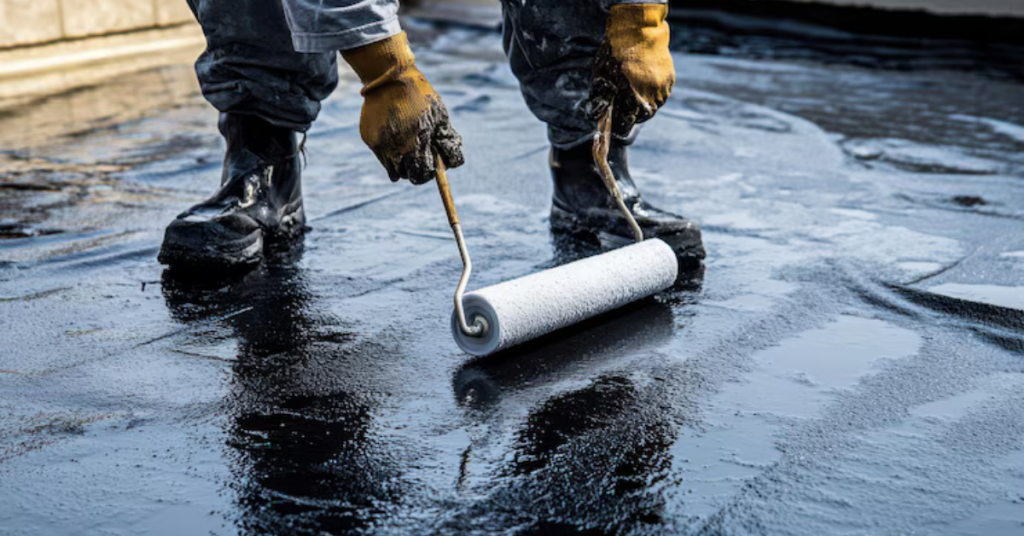
The roofs are often the most neglected part of a building which they begin to leak. A compromise can have a domino effect of issues by water damage from the roof, stained roof and peeling paint from structural decay and health hazards. Bad thing? This damage occurs silently over time. You cannot notice it until the cost of repair becomes unavoidable. This is where the roof waterproofing plays a preventive solution designed to prevent water loss, even before it starts.
The roof waterproofing is the process of planting a protective layer or membrane on the roof surface to prevent water penetration. It is just more than a cosmetic fix or patch job, it is a long term strategy to protect the building from rain, humidity and extreme weather conditions. In areas that experience heavy rains or ups and downs in temperature, roofs expand, contract, and wear it rapidly. Without a proper waterproofing system, even minor cracks and seams can turn into major entry points for water, leading to expensive damage and potential security risk.
Roof waterproofing stops leaks before they start
Among the most salient and direct advantages of a good waterproofing job is leak restriction. Roofs are constantly under attack from environmental elements – wind, sun, rain, and debris. Constant exposure leads to wear and tear- cracking, broken tiles, or damaging seams. Waterproofing systems use certain membranes, sealants, or coatings to seal these weak spots, actually, providing a barrier between your roof and outside moisture. By sealing the leak prior to the failure, the water stain and drips can be prevented.
It protects the internal structure of the building
When the water enters through a compromise roof, it does not harm the roof it leaks in the bones of the building. Over time, it can lead to rusty steel, rated wood and even weak foundations if left uncontrolled. Electrical systems and insulation can also be affected, which can cause fire hazards and inability to energy. Waterproofing helps to keep these risks out water, which should not reach out of areas. With a safe waterproofed roof, you can preserve the longevity of your structure and avoid large -scale repair costs in the future
Prevents mold and mildew growth
It creates a wet environment that promotes mold growth as well as mildew especially on hidden locations such as AATX or roof panel. The damage caused by mold is purely structural; It rotates quietly to affect the scenarios where a person has respiratory conditions such as asthma or allergies. Waterproofing will go a long way in preventing moisture from leaking into the roof space such that it makes your home or business dry and safe. No moisture means no mold and fungi growth and that is where better quality of indoor air and healthy indoor environment exist.
Improves energy efficiency and insulation
To keep water out, waterproofing is one step, but the second is to save energy in the building. When the insulation of a building gets wet, it loses thermal resistance, and thus the building tends to remain hot in summer and cool in winter. When a roof is waterproofed, it is then dry and works as insulation. Some modern materials used for waterproofing take on the role of reflectivity they would defame sunlight and reduce the thermal absorption thereof. Better work goes to providing comfortable indoor temperatures and significant savings on the electricity bill.
Extends the lifespan of your roof
Roofs are expensive property, and regular replacement or major repairs can quickly remove your maintenance budget. Waterproofing expands the lifetime of your roof by avoiding natural wear and tears, especially water -related issues that expedite the decline. By adding an additional layer of defense against the elements, roof waterproofing reduces the effect of UV rays, temperature changes, and water infiltration. Result? A long -lasting roof that only performs well for decades with regular maintenance.
FAQ About How Can Roof Waterproofing Prevent Water Damage
Q1: How many times does one burn the roof of a house?
It’s roof to roof based and it depends on the waterproofing system used and the type of local climate where a person resides. Typically, most systems need inspection or reapplication after about 5-10 years. It is best to do an annual maintenance probe to prolong your efficacy.
Q2: Can I throw my roof on my own?
For people with DIY kits, they are not comparable to the professional waterproofing because they in fact are not able to prepare appropriately the surface, select the right products to be used, and apply correctly to have long-lasting results and peace of mind.
Q3: Which roofs are waterproofed?
Almost all roofs such as concrete roof, metal roof, tile roof, flat roof, etc. can be waterproof. Different techniques and raw materials used in waterproofing depend mainly on the type and condition of the roof.
Q4: Does waterproofing does harm for the environment?
Yes, as a matter of fact, most end-users can find energy-efficient and eco-friendly waterproofing materials available in the market today. These materials help to reduce the cooling costs and cut down the entire carbon footprint.


